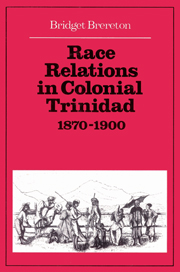Book contents
- Frontmatter
- Contents
- Acknowledgements
- Glossary
- 1 Introduction
- 2 The environment
- 3 The white elite
- 4 Education and mobility
- 5 The rise of a coloured and black middle class
- 6 The urban labouring population
- 7 The black rural masses
- 8 The souls of black folk
- 9 The Indians
- 10 Racism and race relations: the divided society
- Abbreviations
- Notes
- Bibliography
- Index
- Frontmatter
- Contents
- Acknowledgements
- Glossary
- 1 Introduction
- 2 The environment
- 3 The white elite
- 4 Education and mobility
- 5 The rise of a coloured and black middle class
- 6 The urban labouring population
- 7 The black rural masses
- 8 The souls of black folk
- 9 The Indians
- 10 Racism and race relations: the divided society
- Abbreviations
- Notes
- Bibliography
- Index
Summary
Of all the immigrant groups which came to Trinidad during the course of the nineteenth century, the Indians were immeasurably the most important. They came in far greater numbers than any other group. Furthermore, they belonged to an intricate, ancient society, with a rigid system of stratification, strongly established non-Christian religions, and a high culture essentially alien to the westernised host society. They constituted an entirely new element in Caribbean societies, an element which would have to find a place in the existing race, class, and caste systems.
The Indians were imported into Trinidad to provide the stable and manageable labour force which, the sugar planters believed, had been lost to them since the full emancipation of the blacks in 1838. Other possible sources of labour had proved inadequate; it was India which proved satisfactory. India had a huge population, millions living close to destitution; most of the sub-continent was under British control, so that there was no necessity for troublesome negotiations with foreign governments; India's climate was not unlike that of the Caribbean, and most of her people were accustomed to agricultural work. The cost of importation, though high, was not prohibitive as it was in the case of China. Trinidad, of course, was only one of several colonies receiving Indian immigrants in the nineteenth century; a global traffic in Indian labourers was established, taking them to Assam, South-East Asia, East Africa, South Africa, Mauritius, the Pacific, and the West Indies.
- Type
- Chapter
- Information
- Race Relations in Colonial Trinidad 1870–1900 , pp. 176 - 192Publisher: Cambridge University PressPrint publication year: 1980

